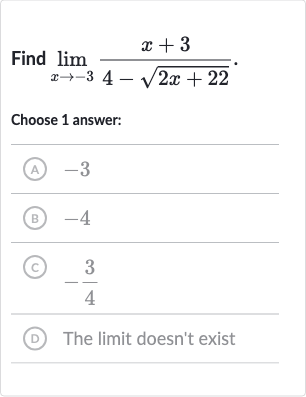Full solution
Q. Find .Choose answer:(A) (B) (C) (D) The limit doesn't exist
- Substitution Attempt: First, let's try to directly substitute the value of into the expression to see if the limit can be evaluated this way.We get an indeterminate form , which means we cannot directly evaluate the limit by substitution.
- Rationalize Denominator: Since direct substitution resulted in an indeterminate form, we need to manipulate the expression to eliminate this form. We can rationalize the denominator by multiplying the numerator and the denominator by the conjugate of the denominator.The conjugate of is .
- Perform Multiplication: Now, let's perform the multiplication in the numerator and the denominator.Numerator: Denominator: The denominator is a difference of squares, which simplifies to:Denominator:
- Simplify Denominator: Let's simplify the denominator further.Denominator: Denominator: Denominator: Now, we can see that the term in the numerator will cancel out with the term in the denominator.
- Cancel Common Terms: Let's cancel out the common terms.Numerator: Denominator: Now, we can cancel out the term from the numerator and denominator.
- Final Substitution: Now, let's substitute into the simplified expression.
More problems from Is (x, y) a solution to the system of equations?
QuestionGet tutor help
QuestionGet tutor help
QuestionGet tutor help
QuestionGet tutor help
QuestionGet tutor help
QuestionGet tutor help
QuestionGet tutor help

